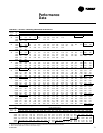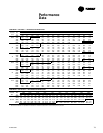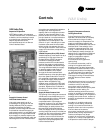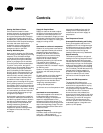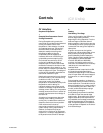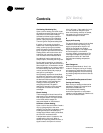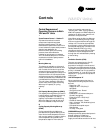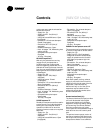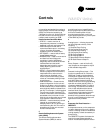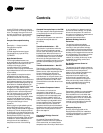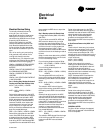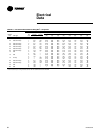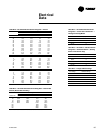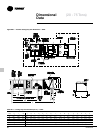
79RT-PRC010-EN
Controls
Control Sequences of
Operation Common to Both
VAV and CV Units
1
Space Pressure Control — Statitrac™
A pressure transducer is used to
measure and report direct space
(building) static pressure. The user-
defined control parameters used in this
control scheme are space static pressure
setpoint and deadband. As
the economizer opens, the building
pressure rises and enables the
exhaust fan and dampers or exhaust
VFD. The exhaust dampers or VFD then
modulate to maintain space pressure
within the deadband.
2
Morning Warm-up
This feature is available on all types of
factory-installed heat units and on units
with no heat, this function may still be
selected to support systems with heat
sources not provided by the rooftop unit.
At the conclusion of Unoccupied mode,
while the economizer (if supplied) is kept
closed, the selected zone is heated to the
user-defined Morning Warm-up setpoint.
The unit is then released to Occupied
mode. There are two types of Morning
Warm-up: full capacity or cycling
capacity.
A
Full Capacity Morning Warm-up (MWU)
Full capacity Morning Warm-up uses full
heating capacity, and heats the zone up
as quickly as possible. Full heating
capacity is provided until the Morning
Warm-up setpoint is met. At this point,
the unit is released to Daytime mode.
B
Cycling Capacity Morning Warm-up
(MWU)
Cycling capacity Morning Warm-up
provides a more gradual heating of the
zone. Normal zone temperature control
with varying capacity is used to raise the
zone temperature to the MWU zone
temperature setpoint. This method of
warm-up is used to overcome the
“building sink” effect. Cycling capacity
MWU will operate until MWU setpoint is
reached or for 60 minutes, then the unit
switches to Occupied mode.
Note: When using the Morning Warmup
option in a VAV heating/cooling rooftop,
airflow must be maintained through the
rooftop unit. This can be accomplished
by electrically tying the VAV boxes to the
unoccupied output relay contacts on the
Rooftop Module (RTM) or by using
changeover thermostats. Either of these
methods will assure adequate airflow
through the unit and satisfactory heating
of the building.
3
Ventilation Override (VOM)
The user can customize up to five (5)
different override sequences for
purposes of ventilation override control.
If more than one VOM sequence is being
requested, the sequence with the highest
priority is initiated first. Priority schedule
is that sequence “A” (unit off) is first, with
sequence “E” (purge with duct pressure
control) last.
UNIT OFF sequence “A”
When complete system shut down is
required the following sequence could
be used.
- Supply fan - Off.
- Supply fan VFD - Off (0 Hz) (if
equipped)
- Inlet guide vanes - Closed
(if equipped).
- Exhaust fan - Off, exhaust dampers -
Closed (if equipped).
- Exhaust fan VFD - Off (0 Hz) (if
equipped)
- Outside air dampers - Closed.
- Heat - all stages - Off, Modulating heat
output at 0 vdc.
- Occupied/Unoccupied output -
Deenergized
- VO relay - Energized
PRESSURIZE sequence “B”
Perhaps a positively pressurized space is
desired instead of a negatively
pressurized space. In this case, the
supply fan should be turned on with inlet
(VAV/CV Units)



